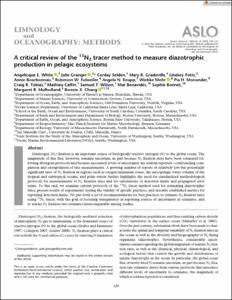| dc.contributor.author | White, Angelicque E. | |
| dc.contributor.author | Granger, Julie | |
| dc.contributor.author | Selden, Corday | |
| dc.contributor.author | Gradoville, Mary R. | |
| dc.contributor.author | Potts, Lindsey | |
| dc.contributor.author | Bourbonnais, Annie | |
| dc.contributor.author | Fulweiler, Robinson W. | |
| dc.contributor.author | Knapp, Angela N. | |
| dc.contributor.author | Mohr, Wiebke | |
| dc.contributor.author | Moisander, Pia H. | |
| dc.contributor.author | Tobias, Craig R. | |
| dc.contributor.author | Caffin, Mathieu | |
| dc.contributor.author | Wilson, Samuel T. | |
| dc.contributor.author | Benavides, Mar | |
| dc.contributor.author | Bonnet, Sophie | |
| dc.contributor.author | Mulholland, Margaret R. | |
| dc.contributor.author | Chang, Bonnie X. | |
| dc.date.accessioned | 2021-08-16T20:25:31Z | |
| dc.date.available | 2021-08-16T20:25:31Z | |
| dc.date.issued | 2020 | |
| dc.identifier.citation | White, A.E., Granger, J., Selden, C., Gradoville, M.R., Potts, L., Bourbonnais, A., Fulweiler, R.W., Knapp, A.N., Mohr, W., Moisander, P.H., Tobias, C.R., Caffin, M., Wilson, S.T., Benavides, M., Bonnet, S., Mulholland, M.R. and Chang, B.X. (2020) A critical review of the 15N2 tracer method to measure diazotrophic production in pelagic ecosystems. Limnology and Oceanography: Methods, 18, pp.129-147. DOI: https://doi.org/10.1002/lom3.10353 | en_US |
| dc.identifier.uri | https://repository.oceanbestpractices.org/handle/11329/1706 | |
| dc.identifier.uri | http://dx.doi.org/10.25607/OBP-1635 | |
| dc.description.abstract | Dinitrogen (N2) fixation is an important source of biologically reactive nitrogen (N) to the global ocean. The
magnitude of this flux, however, remains uncertain, in part because N2 fixation rates have been estimated following
divergent protocols and because associated levels of uncertainty are seldom reported—confounding comparison
and extrapolation of rate measurements. A growing number of reports of relatively low but potentially
significant rates of N2 fixation in regions such as oxygen minimum zones, the mesopelagic water column of the
tropical and subtropical oceans, and polar waters further highlights the need for standardized methodological
protocols for measurements of N2 fixation rates and for calculations of detection limits and propagated error
terms. To this end, we examine current protocols of the 15N2 tracer method used for estimating diazotrophic
rates, present results of experiments testing the validity of specific practices, and describe established metrics for
reporting detection limits. We put forth a set of recommendations for best practices to estimate N2 fixation rates
using 15N2 tracer, with the goal of fostering transparency in reporting sources of uncertainty in estimates, and
to render N2 fixation rate estimates intercomparable among studies. | en_US |
| dc.language.iso | en | en_US |
| dc.rights | Attribution-NonCommercial 4.0 | * |
| dc.rights.uri | http://creativecommons.org/licenses/by-nc/4.0/ | * |
| dc.subject.other | N2 | en_US |
| dc.subject.other | Fixation | en_US |
| dc.title | A critical review of the 15N2 tracer method to measure diazotrophic production in pelagic ecosystems. | en_US |
| dc.type | Journal Contribution | en_US |
| dc.description.refereed | Refereed | en_US |
| dc.format.pagerange | pp.129-147 | en_US |
| dc.identifier.doi | 10.1002/lom3.10353 | |
| dc.subject.parameterDiscipline | Carbon, nitrogen and phosphorus | en_US |
| dc.bibliographicCitation.title | Limnology and Oceanography: Methods | en_US |
| dc.bibliographicCitation.volume | 18 | en_US |
| dc.description.sdg | 14.a | en_US |
| dc.description.eov | N/A | en_US |
| dc.description.adoption | Multi-organisational | en_US |
| dc.description.supportingotherVariables | Nitrogen | en_US |
| dc.description.supportingotherVariables | Dinitrogen | en_US |
| dc.description.methodologyType | Method | en_US |
| dc.description.methodologyType | Specification of criteria | en_US |
| dc.description.methodologyType | Reports with methodological relevance | en_US |
| obps.endorsementAuthorDeclared.recommendedPractice | Ocean Carbon & Biogeochemistry Project | |
| obps.contact.contactemail | julie.granger@uconn.edu | |
| obps.resourceurl.publisher | https://aslopubs.onlinelibrary.wiley.com/doi/full/10.1002/lom3.10353 | |
 Repository of community practices in Ocean Research, Applications and Data/Information Management
Repository of community practices in Ocean Research, Applications and Data/Information Management

